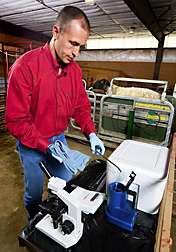Research Yields Sheep Breeding Improvements

(PhysOrg.com) -- Artificial insemination (AI) techniques that work well with cattle and swine can be difficult or costly to perform in sheep, but help’s on the way, thanks to Agricultural Research Service (ARS) studies in Fort Collins, Colo.
There, at the agency’s National Center for Genetic Resources Preservation, animal physiologist Phil Purdy and colleagues are working to improve both the handling of sheep semen and the artificial insemination of ewes, whose cervix is difficult to traverse with traditional AI tools. Purdy is collaborating with ARS animal geneticist Harvey Blackburn and University of Wyoming scientists Bob Stobart and Brent Larson on the effort.
The team’s studies showed that sheep semen can be collected and shipped—in cooled liquid form—overnight before freezing without harming its in-vitro quality. They further determined the semen could be cryopreserved—or frozen—after shipping without reducing its success in surgical AI.
Their studies also compared semen that had been cryopreserved after collection to semen that had been frozen after 48 hours (the time required to ship samples across the country). No differences were observed in semen quality, fertilization ability, or number of lambs born to ewes surgically inseminated with the samples. Potentially, this could open the door to sheep producers’ use of samples from around the world, expanding and improving their breeding options, according to Purdy.
On another front, his team adapted a swine insemination method for use in ewes. It involved using a spiral insemination catheter to traverse the ewe’s cervix and deposit thawed semen directly into the uterus. The method takes about two minutes per sheep and costs $1.29. Though faster, less costly and easier than laparoscopic surgical insemination, the new method so far has had a lower success rate: about 55 percent using fresh semen and 10 percent using frozen semen.
The researchers are investigating how to hone the technique and improve its success rate by improving the timing of estrus and insemination.
Read more about this research in the October 2009 issue of Agricultural Research magazine.
Provided by USDA Agricultural Research Service



















